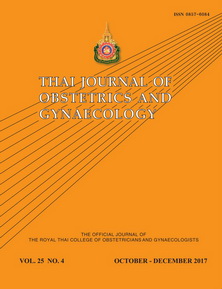Efficacy of Topical Ethyl Chloride Spray versus Subcutaneous 1% Lidocaine Injection in Reducing Pain from One Rod System Implant Insertion
Main Article Content
Abstract
Objectives: To compare the efficacy of topical ethyl chloride spray and subcutaneous 1% lidocaine injection in reducing pain from one rod system implant insertion.
Materials and Methods: Eighty-four women undergoing one rod implant insertion during February 2014 to December 2015 were enrolled and randomly allocated to ethyl chloride spray and 1% lidocaine injection groups. After skin was sterilized, the assigned anesthetic method was administered before insertion of one rod implant according to the standard pro-cedure. Pain during anesthetic administration, implant insertion, 20 min after insertion, and overall pain were evaluated, using a 100-mm visual analogue scale (VAS). Patient and doctor satisfaction were measured using a five-point Likert scale.
Results: All basis clinical characteristics between two groups did not differ. There was no significant difference in VAS during and 20 min after implant insertion between 2 anesthetic groups (p > 0.05). Median VAS during anesthetic administration and overall pain in ethyl chloride spray group (1.50 and 1.60) were significant lower than lidocaine injection group (3.75 and 2.75) (p < 0.01). Patient and doctor satisfaction scores were significant higher in ethyl chloride spray group (p < 0.05).
Conclusion: Ethyl chloride spray can be used as anesthetic option for one rod system implant insertion. It provides comparable analgesic effect to lidocaine injection but with less pain from anesthetic administration.
Keywords: ethyl chloride spray, lidocaine, one rod system implant
Article Details
References
2. Hohmann H, Creinin MD. The contraceptive implant. Clin Obstet Gynecol 2007;50:907-17.
3. Fischer MA. Implanon: a new contraceptive implant. J Obstet Gynecol Neonatal Nurs 2008;37:361-8.
4. Mansour D. Nexplanon®: what Implanon® did next? J Fam Plann Reprod Health Care 2010;36:187-9.
5. Summary of Product Characteristics: Implanon 68 mg implant for sub dermal use. http://emc.medicines.org.uk [Accessed 10 July 2010].
6. The Ministry of Social Development and Human Security [Internet]. Bangkok; 2014 [cited 2015 Sep 27]. Available from:http://www.m-society.go.th/article_attach/14100/17926.pdf
7. Gold MA, Coupey SM. Young women’s attitudes toward injectable and implantable contraceptives. J Pediatr Adolesc Gynecol 1998;11:17-24.
8. Golzari SE, Soleimanpour H, Mahmoodpoor A, Safari S, Ala A. Lidocaine and pain management in the emergency department: a review article. Anesth Pain Med 2014;4:e15444.
9. Reis EC, Jacobson RM, Tarbell S, Weniger BG. Taking the sting out of shots: control of vaccination-associated pain and adverse reactions. Pediatr Ann 1998;27:375-86.
10. Lehmann J, deLateur B. Therapeutic heat and cold. 4th ed. Baltimore: Williams & Wil-kins;1990.
11. Kunesch E, Schmidt R, Nordin M, Wallin U, Hagbarth KE. Peripheral neural correlates of cutaneous anaethesia induced by skin cooling in man. Acta Physiol Scand 1987;129:247-57.
12. Polishchuk D, Gehrmann R, Tan V. Skin sterility after application of ethyl chloride spray. J Bone Joint Surg Am 2012; 94:118-20.
13. Farion KJ, Splinter KL, Newhook K, Gaboury I, Splinter WM. The effect of vapocoolant spray on pain due to intravenous cannulation in children: a randomized controlled trial. Can Med Assoc J 2008;179:31-6.
14. Celik G, Ozbek O, Yilmaz M, Duman I, Ozbek S, Apiliogullari S. Vapocoolant spray vs lidocaine/prilocaine cream for reducing the pain of venipuncture in hemodialysis pa-tients: a randomized, placebo-controlled, crossover study. Int J Med Sci 2011;8:623-7.
15. Robinson PA, Carr S, Pearson S, Frampton C. Lignocaine is a better analgesic than ei-ther ethyl chloride or nitrous oxide for peripheral intravenous cannulation. Emerg Med Australas 2007;19:427-32.
16. Hijazi R, Taylor D, Richardson J. Effect of topical alkane vapocoolant spray on pain with intravenous cannulation in patients in emergency department: a randomised, dou-ble-blind, placebo controlled trial. BMJ 2009; 338: 457-9.
17. Page DE, Taylor DM. Vapocoolant spray vs subcutaneous lidocaine injection for reduc-ing the pain of intravenous cannulation: a randomized, controlled, clinical trial. Br J Anaesth 2010;105:519-25.
18. Armstrong P, Young C, McKeown D. Ethyl chloride and venepuncture pain: a compari-son with intradermal lidocaine. Can J Anaesth 1990;37:656-8.
19. Costello M, Ramundo M, Christopher NC, Powell KR. Ethyl vinyl chloride vapocoolant spray fails to decrease pain associated with intravenous cannulation in children. Clin Pediatr 2006;45:628-32.
20. Hartstein BH, Barry JD. Mitigation of pain during intravenous catheter placement using a topical skin coolant in the emergency department. Emerg Med J 2008;25:257-61.
21. Ho K, Spence J, Murphy M. Review of pain measurement tools. Ann Emerg Med 1996;27:427-32.
22. Selby IR, Bowles BJ. Analgesia for venous cannulation: a comparison of EMLA (5 minutes application), lignocaine, ethyl chloride, and nothing. J R Soc Med 1995;88:264-7.
23. Biro P, Meier T, Cummins AS. Comparison of topical anaesthesia methods for venous cannulation in adults. Eur J Pain 1997;1:37-42.

